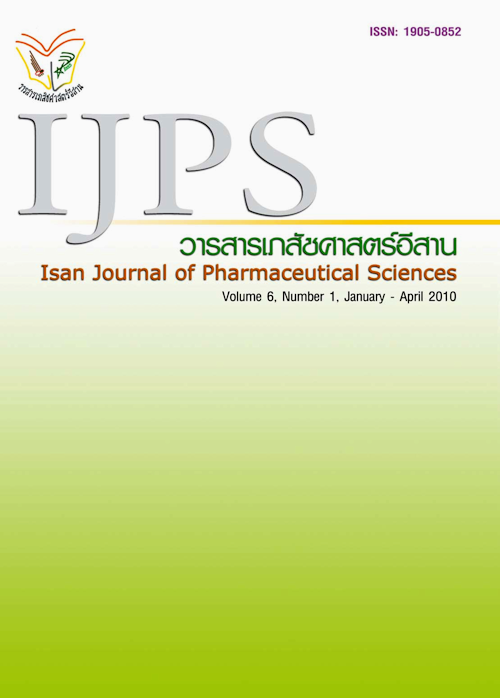Adherence to Evidence Based Guideline in Treatment of Hypertension
Main Article Content
Abstract
Evidence Based Guideline in Treatment of Hypertension improves cardiovascular outcomes. The
objective of this study was to assess the adherence to the treatment of hypertension following the Joint
National Commission on Prevention, Detection, Evaluation, and Treatment of High Blood Pressure (JNC)
guidelines in 2001 (JNC VI) and 2005 (JNC VII). This study was a retrospective cross-sectional study
in hypertensive patients who received medications or registered for the treatment (ICD 10) beginning in
January 2001 following through December 2005. Medication review, blood pressure, laboratory test,
hospital admission, death were assessed. There were 1,015 patients, and sampling for 168 patientsû
profile which 102 patientsû profile were completed for analysis. The average age was 61.1±11.8 years.
Most of them were female (70.6%) and had only hypertension (49.0 percent). Most of the patients
received monotherapy (49.0%). The frequently prescribed medications were diuretics (39.2%),
angiotensin-converting enzyme inhibitors (35.3%). During 5 years of study, there were 5 patients died
and 4 of them died from cardiovascular disease. Average hospital admission rate was 1.86 times per
patient in 2003. No difference significance in blood pressure at the time comparing between in 2001 and
2005. Overall percentage of adherence to treatment according to JNC VI was 56.7% in 2001 and
according to JNC VII guideline was 46.43% in 2005 Prospective study may show more clinical practice
changes adhering to the guidelines.
Article Details
In the case that some parts are used by others The author must Confirm that obtaining permission to use some of the original authors. And must attach evidence That the permission has been included
References
Berlowitz DR, Ash AS, Hickey EC, et al. Inadequate management of blood pressure in a hypertensive population. N Engl J Med 1998; 339: 1957›1963.
Chinwong S. The quality of prescribing among diabetes mellitus type 2 patient without a history of coronary heart disease (Ph.D. Thesis). UK.: Strathclyde University; 2004.
Chobanian A, Bakris G, Black H et al. The Seventh Report of the Joint National Committee on Prevention, Dectection, Evaluation and Treatment of High Blood Pressure. Hypertension 2003; 42: 1206 - 1252.
Joint National Committee on Prevention, Detection, Evaluation, and Treatment of High Blood Pressure. The sixth report of the Joint National Committee on Prevention, Detection, Evaluation, and treatment of High Blood Pressure. Arch Intern Med 1997; 157: 2413-2446.
Joint National Committee on Prevention, Detection, Evaluation, and Treatment of High Blood Pressure. The seven report of the Joint National Committee on Prevention, Detection, Evaluation, and treatment of High Blood Pressure. JAMA 2003; 289 (19): 2560- 2572.
Meissner I, Whisnant J, Sheps E, et al. Detection and control of high blood pressure in the community: do we need a wake-up call? Hypertension 1999; 34: 466-471.
Milchak LJ, Carter LB, James AP, Dawson DJ. Physician adherence to JNC 7 guidelines and blood pressure control. Am J hypertens 2005; 8: A190.
Neal B, MacMahon S and Chapman N. Effects of ACEI, calcium antagonists, and other blood-pressure-lowering drugs: Results of prospectively designed overviews of randomized trials. Blood Pressure Lowering Treatment Trialists' Collaboration. Lancet 2000; 356: 1955-1964.
Sechi LA. Correspondence: Inadequate manage- ment of blood pressure in a hypertensive population. N Eng J Med 1999; 340(20): 1593-1595.
Steinman AM, Fischer AM, Shlipak MG, et al. Clinician awareness of adherence to hypertension guidelines. Am J Med 2004; 117: 747 › 754.


